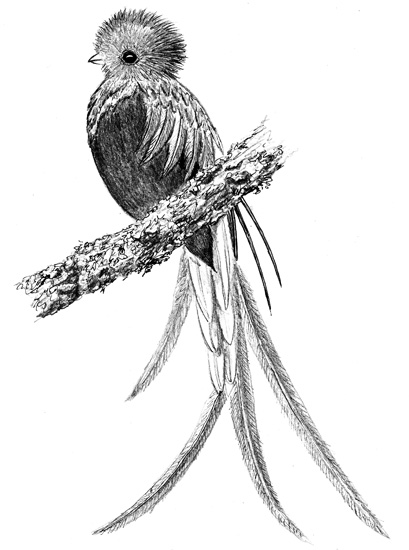
To Review:
Last week Todd wrote in to ask if I had ever seen a quetzal (pronounced ket-sall, not kwet-zal or Ketchup), a bird that lives in the mountains of Central America. I responded by saying that I had indeed seen a quetzal, and that it was the most impressive bird I had ever focused my binoculars on. I explained how I, along with my friend Jonesy, traveled to Costa Rica, took a hair-raising ride up a mountain road to the famous Monteverde Cloud Forest Reserve, which is home to quetzals. When we arrived at the reserve it was late in the day, but we stupidly decided to head out and look for the quetzal anyway. Not long after we started our search the sun began to set and we became lost and disoriented. As the light faded, and we tried to get our bearings, we suddenly heard a loud rustling in the branches over our heads. Fearing that some vicious jungle creature was about to descend upon us, we nervously looked up and OMG!
This is where I left off last week and I can’t wait to find out what happens next. So, let’s continue, shall we? The thick canopy above us was dark, except for a few lit branches that were still grabbing the last rays from the setting sun. As we stared up, imagining all kinds of heinous things, out stepped a totally stunning, brightly sunlit male quetzal. My jaw actually dropped. It was OMG, for real. Jonesy and I stood in dead silence, watching this beautiful bird pick some fruit off the branch, preen a bit and then fly away. I looked at my birding friend, gave out a loud yell and we both started high-fiving each other…but no hugs. (Back then man hugs hadn’t been invented yet, but the high-fives turned out to be a mistake. I was so excited that I accidently hit Jonesy on the forehead and he ended up knocking my hat off, but we didn’t care.)
There are several species of quetzals in Central and South America, but the Resplendent Quetzal, the bird we had just seen, is by far the most stunning. In fact, the word “resplendent” means stunning. (I know that because I just looked it up.) Depending upon the lighting, the quetzal’s wings and back either look brilliant green or iridescent blue. The head, which is also green, is kind of fuzzy, resembling a kiwi with eyes. The chest and belly are radiant crimson and the wing feathers extend along its sides, making the bird look like it’s wearing a royal cape. But this bird’s main feature is the tail. During the breeding season the male grows three-foot-long plumes, which flow behind him as he flies. Can you imagine? Hold your hands three feet apart. That’s crazy long. I can’t keep my seatbelt from getting all twisted up, yet this bird can somehow fly through the rainforest without getting its three-foot-long tail tangled.
The Resplendent Quetzal is widely considered to be the most beautiful bird in the world…in the entire world! Long before birders became obsessed with it, both the Mayans and the Aztecs held the quetzal in high reverence. The people of Guatemala love this bird so much they’ve named their currency after it. How cool is that? Other countries have boring monetary units like the dollar, the pound and the yen, but Guatemalans pay their bills in quetzals.
To be sure, the tropics contain other striking birds, including macaws and parrots, but to many folks macaws and parrots lost their specialness years ago. Those poor birds have been jammed into cages, displayed in restaurants and trapped apartments for so long that now they just look sad. Resplendent Quetzals, on the other hand, don’t do well in captivity and thus have avoided suffering the same fate. With few exceptions, the only way to see a Resplendent Quetzal is to make a trip to where they live, which is what we had done. This brings us back to the two goofball birders from Cape Cod (remember them?), who were still lost in the Costa Rican jungle.
Like having a glass of ice water splashed in our faces (or getting high-fived on the forehead), the jolt of seeing the quetzal snapped us out of our funk. Suddenly, Jonesy was able to figure out the map and got us headed in the right direction. Walking quickly (sprinting really), we were able to find our way back to the parking area before it became completely dark and before the snakes came out. Whew!
But even though we were out of the jungle, we weren’t out of the woods. We still had to get off the mountain and travel back down the road from hell, but that’s another story for another time. Although I will tell you that things around Monteverde have changed quite a bit in the past twenty-five years. Now they have zip-lines, canopy walks and fancy places to stay. Don’t get me wrong, the mountain road is still plenty scary, but in recent years they have made huge improvements. In fact, I’ve heard that tour buses are now able to make the trek. Tour buses! It doesn’t seem possible. I wonder what my friends the goats think about that.
Thanks for asking about the quetzal, Todd. It is one bird that isn’t over-hyped. As I said last week, I still get goose bumps thinking about it. And as much as I like birds, there aren’t many birds I’d face treacherous mountain roads and snakes to see. But I’m really glad I did all that to see the Resplendent Quetzal…and I’d do it again. Heck, the next time I see one I might even give out man hugs…just don’t tell Jonesy.